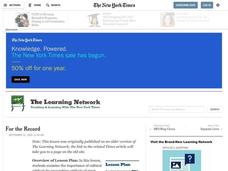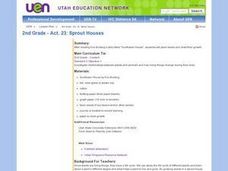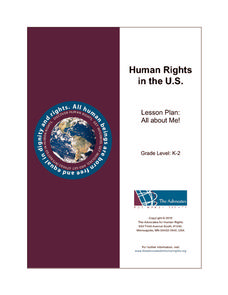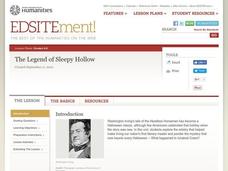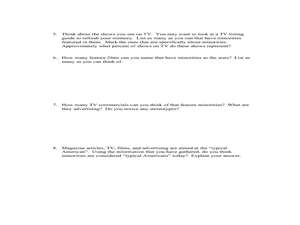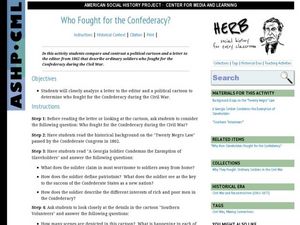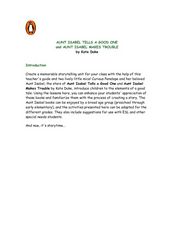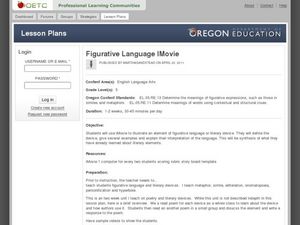Curated OER
For the Record
Students read a New York Times article in order to examine the importance of cultural artifacts. They create essays from the point of view of one cultural artifact to demonstrate the knowledge they gained by doing research.
Curated OER
Compare Two Versions: Folk Tales, Sequencing, and Summary
Compare two versions of "The Three Little Pigs" (traditional and Jon Scieszka's The True Story of the Three Little Pigs, told from the wolf's point of view). As your 4th graders recount the familiar version of the story, emphasize the...
Alabama Learning Exchange
Yummy Apples!
Young learners listen to a read aloud of Gail Gibbons book, Apples and the story A Red House With No Windows and No Doors. They compare characteristics of a number of kinds of apples, graph them and create a apple print picture. Learners...
Curated OER
2nd Grade - Act. 23: Sprout Houses
Read the story "Sunflower House," by Eve Bunting with your 2nd graders to investigate the relationships between plants and animals. They will discover how living things change during their lives by creating their own sprout houses. In...
Curated OER
Character Bust: Ceramics Lesson
Whether it is a protagonist, antagonist, hero or heroine, characters are a must in any story. Learners analyze a character from a narrative they are reading, then use that character as inspiration. They create a ceramic bust depicting...
Curated OER
Mucket Mania: The Mussel Industry in Arkansas
Middle and high schoolers read and discuss articles about the mussel industry in Arkansas. They pay close attention to the history of pearling and button making industries on the Black and White Rivers of Arkansas. This impressive,...
Curated OER
Propaganda
How does word choice affect the reading of a text? Compare two headlines that were written about the same event. Is one biased? Discuss how word choice often reveals the author's feelings about a topic. Then look at different techniques...
Curated OER
Dental Detectives
First graders explore the theme of dental health and hygeine. They make tooth loss predictions, count lost teeth, and graph tooth loss. In addition, they listen to dental health stories, read online stories, create spreadsheets, and play...
Curated OER
Lift the Math Curse
Students complete a variety of activities related to the book "Math Curse" by Jon Scieszka. They write a story about a day in their life that includes illustrations, fifteen math problems, the written story, and an answer key. Students...
Curated OER
Visual Arts - Mexican Indian Yarn Painting
Have you ever seen a Mexican yarn painting? They're beautiful! Create a Mexican yarn painting with your class using this instructional activity. Start by discussing Mexico's culture and viewing different yarn paintings. After reading...
Curated OER
Introduction to Main Events
Identify main events in a text. Readers will read The Kissing Hand and discuss the main events of the story. They will use sentences strips to write down events and place them in order. Alternative books are suggested.
Curated OER
All About Me
Students identify personal traits. In this autobiographical art lesson, students read the book Whoever You Are and use art supplies to create a body cut-out of themselves. Students include physical characteristics on their cut out.
Curated OER
The Legend of Sleepy Hollow
Explore Washington Irving's "The Legend of Sleepy Hollow" in this literature analysis lesson. Middle schoolers read and summarize the plot of the story. They then adapt passages for a contemporary audience and analyze the...
Curated OER
Minorities in Mainstream American Society
So many people fought for Civil Rights in the United States. Read about the Civil Rights Act of 1964, and discuss what the act guarantees. Then pass out a slew of magazines and encourage them to observe how often minorities appear in...
Curated OER
My Secret War: Lesson 1
Fifth graders explore historical fiction. In this genre study lesson plan, 5th graders go on a text feature scavenger hunt to identify the parts of a historical fiction text. Additionally, students read the book, My Secret War and...
Curated OER
My Secret War: Lesson 5
Fifth graders determine how freedom comes with rights and responsibilities through literature and poetry about World War II. In this World War II lesson, 5th graders use the letters in the word "infamy" to write an acrostic poem. They...
Curated OER
Counting Up/Down Stories
Mirroring Jerry Spinelli's style in Wringer, chapter 5, pupils use the "counting up/down technique" to recall an important moment in their lives. In the book, the character is being punched, and between blows he remembers details that...
Curated OER
Why Transition?
Help your class transition into better writers with this lesson, which guides them through the process of adding transitions to increase sentence fluency and organization. The activity is designed for a classroom with a SMART board, but...
Curated OER
Impersonating Great Poets Using "Science Verse" by Jon Scieszka
A great way to bring poetry and parody into your language arts classroom, this lesson mimics famous poems based on Jon Scieszka's Science Verse. The activity not only allows the class to see examples of poem parodies, but to create their...
Curated OER
Who Fought for the Confederacy?
Did the Confederate Army really consist of southern volunteers? Using primary sources, historians examine the story behind the "Twenty Negro Law" and realities of conscription during the Civil War. A letter and a lithograph (included as...
Curated OER
Aunt Isabel Tells a Good One...
Explore language arts by reading two similar stories in order to compare and contrast them in class. Young readers read two Aunt Isabel books, by Kate Duke, and discuss the main characters, plot, and setting. They complete a graphic...
Curated OER
Little Red Hen Bakes Bread
Students investigate the bread baking process through the use of literature. In this reading comprehension lesson, students read the book, The Little Red Hen and discuss the steps the hen followed to bake bread. Students bake the bread...
Curated OER
Figurative Language iMovie
In order to understand figurative language, learners read 5 poems, each exemplifying a different literary device. They discuss and write responses to each poem. They then choose one literary device which they will use as the basis for a...
Illustrative Mathematics
1.OA, NBT, The Very Hungry Caterpillar
First graders are exposed to addition of three whole numbers in a math activity centered around Eric Carle's, The Very Hungry Caterpillar. As the teacher reads, young mathematicians use counters and ten-frames to symbolize the number of...
Other popular searches
- Kindergarten Shared Reading
- Shared Reading Lesson Plans
- Shared Reading Lessons
- Shared Reading Owl Moon
- Shared Reading and Science
- Shared Reading Experience
- Shared Reading and Math
- Shared Reading Strategy
- Shared Reading Non Fiction
- Shared Reading Stellaluna
- Shared Reading Lessons Rome
- Shared Reading Inferences


